
George Glenn Jones was an American country musician, singer, and songwriter. He achieved international fame for a long list of hit records, and is well known for his distinctive voice and phrasing. For the last two decades of his life, Jones was frequently referred to as "the greatest living country singer", "The Rolls-Royce of Country Music", and had more than 160 chart singles to his name from 1955 until his death in 2013.

Ernest Dale Tubb, nicknamed the Texas Troubadour, was an American singer and songwriter and one of the pioneers of country music. His biggest career hit song, "Walking the Floor Over You" (1941), marked the rise of the honky tonk style of music.
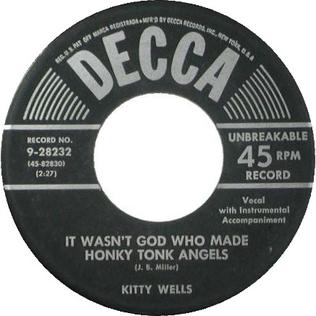
"It Wasn't God Who Made Honky Tonk Angels" is a 1952 country song written by J. D. "Jay" Miller, and recorded by Kitty Wells. It was an answer song to the Hank Thompson hit "The Wild Side of Life." First performed by Al Montgomery as "Did God Make Honky Tonk Angels" on the Feature label which was owned by songwriter J.D. Miller.
"He Stopped Loving Her Today" is a song recorded by American country music artist George Jones. It has been named in several surveys as the greatest country song of all time. It was released in April 1980 as the lead single from the album I Am What I Am. The song was Jones's first solo No. 1 single in six years. It was written by Bobby Braddock and Curly Putman. The week after Jones' death in 2013, the song re-entered the Hot Country Songs chart at No. 21. As of November 13, 2013, the single has sold 521,000 copies in the United States. Since 2008 it has been preserved by the Library of Congress in the National Recording Registry. The song was ranked no. 142 on Rolling Stone's 2021 500 Greatest Songs of All Time ranking.

Jean Shepard was an American country singer who was considered by many writers and authors to be one of the genre's first significant female artists. Her early successes during the 1950s decade were said to influence the future careers of Loretta Lynn, Dolly Parton and Tammy Wynette.
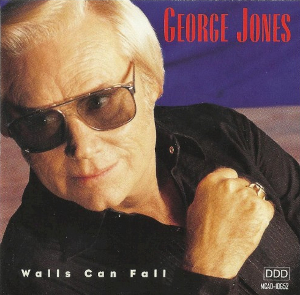
Walls Can Fall is an album by American country music artist George Jones. This album was released in 1992 on the MCA Nashville Records. It peaked at number 24 on the Billboard Country Albums chart and number 77 on The Billboard 200 chart. Walls Can Fall went Gold in 1994.

We Found Heaven Right Here on Earth at "4033" is an album by American country music artist George Jones released in 1966 on the Musicor Records label. The album features "Walk Through This World With Me", which would become a number one hit for Jones in 1967, his first chart topper in five years. According to Bob Allen's book George Jones: The Life and Times of a Honky Tonk Legend, Jones was less than enthusiastic about the "musically middle-of-the-road love ballad that was almost inspirational in its unabashedly optimistic and romantic sentiments – a far cry from 'The Window Up Above,'" and it was only at his producer H.W. "Pappy" Daily's insistence that he recorded the song at all. "From Here To The Door" was written by Don Chapel, who was married to Tammy Wynette at the time. We Found Heaven Right Here on Earth at "4033" would rise to number 3 on the country album chart.
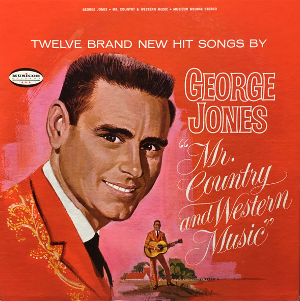
Mr. Country & Western Music is an album by American country music artist George Jones released in 1965 on the Musicor Records label.

My Favorites of Hank Williams is an album by American country music artist George Jones. It was released in 1962 on the United Artists record label. It was Jones' second tribute to the music of Hank Williams.

Sings Country and Western Hits is the 1961 country music studio album released in May 1961 by George Jones. The album was Jones' tenth studio album release since his debut LP in 1956. It would be one of his last with Mercury Records, as he switched to United Artists in late 1961.

Grand Ole Opry's New Star is the debut studio album released by George Jones in November 1956 with Starday Records. Produced by Jones' manager Pappy Daily, the album was recorded during early sessions in 1954, throughout 1955, and other sessions in 1956. It is also the first album to be released on the Starday label, a label only four years old.
"The Grand Tour" is a song made famous by country music singer George Jones. Originally released in 1974, the song was the title track to his album released that year. The song became Jones' sixth No. 1 song on Billboard's Hot Country Singles chart in August 1974, and was the fourth-biggest hit of the year. In 2014, Rolling Stone named the song number 38 on its "40 Saddest Country Songs of All Time".

"Why Baby Why" is a country music song co-written and originally recorded by George Jones. Released in late 1955 on Starday Records and produced by Starday co-founder and Jones' manager Pappy Daily, it peaked at 4 on the Billboard country charts that year. It was Jones' first chart single, following several unsuccessful singles released during the prior year on Starday. "Why Baby Why", has gone on to become a country standard, having been covered by many artists.
"The Window Up Above" is a song written and originally recorded by American country music artist George Jones. The version recorded by Jones peaked at number #2 on the country charts and spent a total of 34 weeks on the chart. It became a #1 smash for Mickey Gilley in 1975.
"Same Ole Me" is a song written by Paul Overstreet, and recorded by American country music artist George Jones with The Oak Ridge Boys. It was released in January 1982 as the second single and partial title track from Jones' album Still the Same Ole Me. The song reached number 5 on the Billboard Hot Country Singles chart and number 1 on the RPM Country Tracks chart in Canada.
"Loving You Could Never Be Better" is a song written by Earl Montgomery, Charlene Montgomery and Betty Tate, and recorded by American country music artist George Jones. It was released in April 1972 as the second single from his album George Jones . The song peaked at number 2 on the Billboard Hot Country Singles chart. It also reached number 1 on the RPM Country Tracks chart in Canada. The song was a good example of how producer Billy Sherrill had updated the sound of Jones' records, incorporating a laid back, R&B bass line. By drawing from such unlikely and disparate musical influences as Johann Strauss and "wall of sound" rock producer Phil Spector, he gradually began embroidering his own subtle permutations on the rather predictable fabric of country record production. "I just decided I'd do it my way, and screw 'em if they didn't like it," Jones biographer Bob Allen quotes Sherrill. "Back then, the musicians had their own repertoire of stock Nashville licks and chord progressions that would work on any song. But I often wanted something different, and I'd make 'em play it."
"What Am I Worth" is a 1956 country music song released by George Jones, co-written by Jones and Darrell Edwards. The song was released on January 14, 1956 and was one of the fourteen songs included on Jones' debut album with Starday Records in 1957.
"I'll Follow You (Up to Our Cloud)" is a song by George Jones. It was written by David Turner.
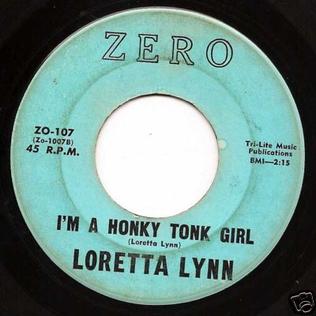
"I'm a Honky Tonk Girl" is the debut single by American country music artist Loretta Lynn, released in March 1960. The song was among the first to not only be recorded by Lynn, but also to be penned by her. She composed the song while living in Washington State, maintaining her role as a housewife and occasional member of a local country music band. The composition was later recorded in California after Lynn was given money by a local businessman, who was impressed by her singing. "I'm a Honky Tonk Girl" was then issued as a single under the newly founded and independent Zero Records label in March 1960.
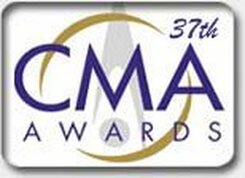
The 2003 Country Music Association Awards, 37th Ceremony, was held on November 5, 2003 at the Grand Ole Opry House, Nashville, Tennessee, and hosted by CMA Award Winner, Vince Gill. Toby Keith lead the evening with 7 nominations, including Album of the Year, and Entertainer of the Year. Alan Jackson and Johnny Cash (posthumously) took home the most awards with 3 each.












